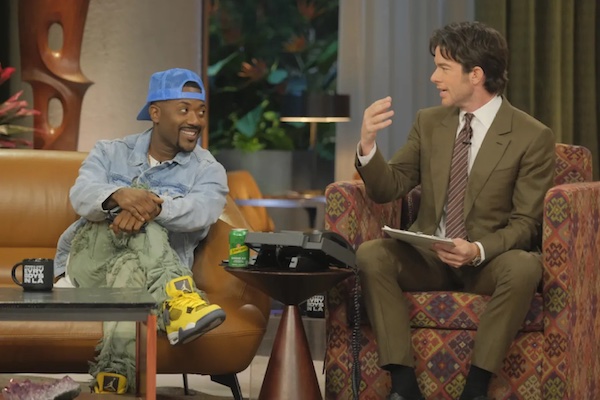Television Review: “Everybody’s in L.A.” — Could Use Some Tweaking
By Matt Hanson
If the show had its format tweaked a little bit, it might hit a sweet spot: somewhere between The Daily Show’s investigative reports and Conan O’Brien’s zanier segments.

A scene from an episode of Everybody’s in L.A. Photo: Netflix
At the beginning of one of the episodes of his new Netflix talk show, Everybody’s in L.A., John Mulaney explained to the camera that, contrary to what one might assume, he’s actually trying to do a good job. Mulaney’s series had a limited run of six episodes and there’s no indication that there will be any more. And that is too bad. Even though the show could be sloppy and lazy, it had more than enough potential for Netflix to renew it.
The usual late-night TV format (monologue, sketch, guests, close with comedian or music) became venerable because it is so efficient. It has served decades of hosts of varying degrees of talent. The problem is that the set-up becomes more than a little formulaic; watch it long enough and you can start anticipating the punchlines. So why not play a little jazz with it? Mulaney is probably best known as a standup comedian with a long record as a writer (SNL, most notably). He brought to this series the spontaneity of a jokester and an eye for the absurd of a seasoned comedy writer.
The relaxed-looking studio resembled an apartment with a long couch and a couple of chairs for guests who had a relationship to the City of Angels, be they locals or well-acclimated transplants. The lineup of guests was a rich blend: these included currently well-known comedians (Jerry Seinfeld, Mike Birbiglia) and some who aren’t so famous (Earthquake, Luenell). Mixed in were normal people who happened to be experts in the L.A.-centric topic of the day, which varied from helicopters to palm trees to haunted houses.
For someone like me, who has never set foot in the city but has always been intrigued by the art it produces, it was interesting to hear bits of insider gossip about L.A. — subjects like plate tectonics or what is it like to be a veteran journalist in a city filled with celebrity malfeasance. These were topics worth mulling over, even as the comics riffed on the more idiotic implications of the La Brea Tar Pits. Talk shows often serve as showcases for guests who are charged with promoting themselves via charming stories about themselves. What’s wrong with having them talk about something that has some weight to it? Chatting about something real can be funnier than whatever canned comic yarn they’ve cooked up for the segment.
As for the field pieces, they were pretty hit and miss. Bursts of documentary style footage featuring eccentric Angelenos were fun and interesting. A guy who has painted billboards on the Sunset Strip for years might have been a fascinating person to have as a guest. Some other bits didn’t really land. Putting the colorful Red Hot Chili Peppers bassist Flea in an undisclosed location and then having audience members find him fell flat. Surreal character-based sketches, where people like Will Ferrell portrayed ridiculous L.A. characters giving increasingly boring interviews, went nowhere. I liked how the little delivery robot Wayso would interrupt the discussions, but the gag could have been used to better comedic effect. How about trying something from the old David Letterman show playbook: give random people a camera and send them out into the city, maybe to hand out free snack food?
Amiable character actor Richard Kind was the announcer/sidekick, and for me that was a hilarious touch given that the performer isn’t particularly well known. His earnestness as he went about doing his job ended up adding a distinctive charm to the show. Seeing him bopping around to Warren G’s ’90s classic gangsta rap tune “Regulate” was delightful. At times, it seemed as though Kind was really flying by the seat of his pants, asking the guests questions that had just occurred to him. That spontaneous conversational tone suited Everybody’s in L.A. well.
Hopefully, Netflix or some other streaming service will give Mulaney another chance. If the show had its format tweaked a little bit, it might hit a sweet spot: somewhere between The Daily Show’s investigative reports and Conan O’Brien’s zanier segments. How about more call-ins from curious locals and fewer scattershot pretaped bits? Cut the runtime to an hour at most rather than the current, somewhat bloated, feature-length running time. Why not take the show on the road — do a week in different cities? Perhaps some weeks could be spent doing a deep dive mixing it up with locals and experts in Detroit, say, or maybe Nashville, or Santa Fe. How about a trip through Mulaney’s native Chicago?
Fully aware of the show’s chaotic nature, Mulaney commented at one point, “This show will make sense when Los Angeles makes sense.” There might be some method to that madness. Why not dive into the absurdity if given another chance? Send the inquisitive, snarky, deadpan host out and about to explore more of the weirdness of a famous, infamous, fabulously freaky city, one that people fallaciously think they already know.
Matt Hanson is a contributing editor at the Arts Fuse whose work has also appeared in the American Interest, the Baffler, the Guardian, the Millions, the New Yorker, the Smart Set, and elsewhere. A longtime resident of Boston, he now lives in New Orleans.
